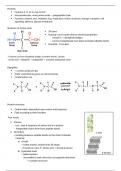Proteins
Contains C, H, O, N, may hv S/P
Macromolecules, many amino acids -> polypeptide chain
Function: enzyme rxns, oxidation (e.g. respiratory chain), structure, storage, transport, cell
signalling, defence, plasma membrane
Structure of amino acids:
20 types
R group: can hv quite diverse chemical properties
contain S -> disulphide bridges
can be charged/polar/non-polar/aromatic/alkaline/acidic
Essential – from diet
*Cysteine can form disulphide bridges (covalent bonds), Glycine
*amino acid -> dipeptide -> polypeptide -> complete polypeptide chain
Dipeptide:
= 2 amino acids join tgt
Order controlled by genes on chromosomes
Condensation rxn
Protein structure:
Conformation dependent upon amino acid sequence
Fold according to their function
Four levels:
1. Primary
= no., type & sequence of amino acid in a protein
Polypeptide chains form from peptide bonds
2. Secondary α-helix
= bonding between peptide bonds on the chain (H bonds)
Could be:
a) α-helix
= coiled protein, twisted into 3D shape
H bonds in every 3rd amino acid -> strong structure
b) β-pleated sheet
β-pleated
= folded protein
lie parallel to each other but run opposite directions
-> complex structure




